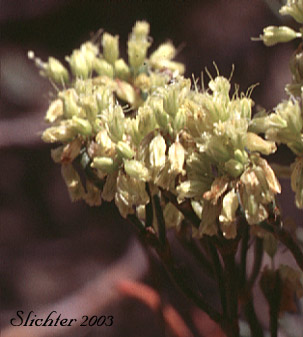
 The
photo at right shows a close-up of part of the upper stem and unopened inflorescence
of slenderbush buckwheat (variety microthecum) as seen along US Highway
26 east of Mitchell, OR.......September 6, 1999.
The
photo at right shows a close-up of part of the upper stem and unopened inflorescence
of slenderbush buckwheat (variety microthecum) as seen along US Highway
26 east of Mitchell, OR.......September 6, 1999.
Slenderbush buckwheat is a shrubby, erect perennial with leafy stems and a flat-topped, umbel-like inflorescence.Plants range from 10-40 cm high. The leaf blades are linear, oblong, linear-oblanceolate or narrowly obovate in shape and narrow gradually to a short petiole. The blades are somewhat tomentose but green on the upper surfaces and gray tomenotse below. Entire leaves range from 1-3 cm long. The leaves are numerous on the stems and may be found over half the length of the flower branches.
The inflorescence is like a freely-branched umbel that is two to six times divided. The conical involucres are are borne singly, 2-2.5 mm long and with glabrous to sparsely tomentose involucres. The white, pink or yellow perianth is 2-2.5 mm long and glabrous externally. The perianth parts are united half their length with the outer lobes rounded and the inner lobes much narrower.
Variety effusum: Plants with white or pink flowers. Leaves 2-4 cm long but without curled margins. The inflorescence ranges from 6-20 cm long. Found from southeastern Idaho east to southern Montana, Utah and New Mexico.
Variety laxiflorum: Plants with white or pink flowers. Leaves up to 2 cm long and typically with curled margins. The inflorescence is less than 5 cm long. Found from northcentral Washington and east to northern Montana, Wyoming, Colorado and Nebraska and southward to Nevada and California.
Variety microthecum: Plants with yellow flowers. Plants of the John Day River Valley and also found around Weiser, Idaho.
Slenderbush buckwheat is found in the arid plains and low mountains slopes, often amongst sagebrush.
Slenderbush buckwheat may be found from the eastern base of the Cascade Mts from central Washington south to California and the Sierra Nevada mts and east to Montana, Nebraska, Colorado, New Mexico and Arizona.